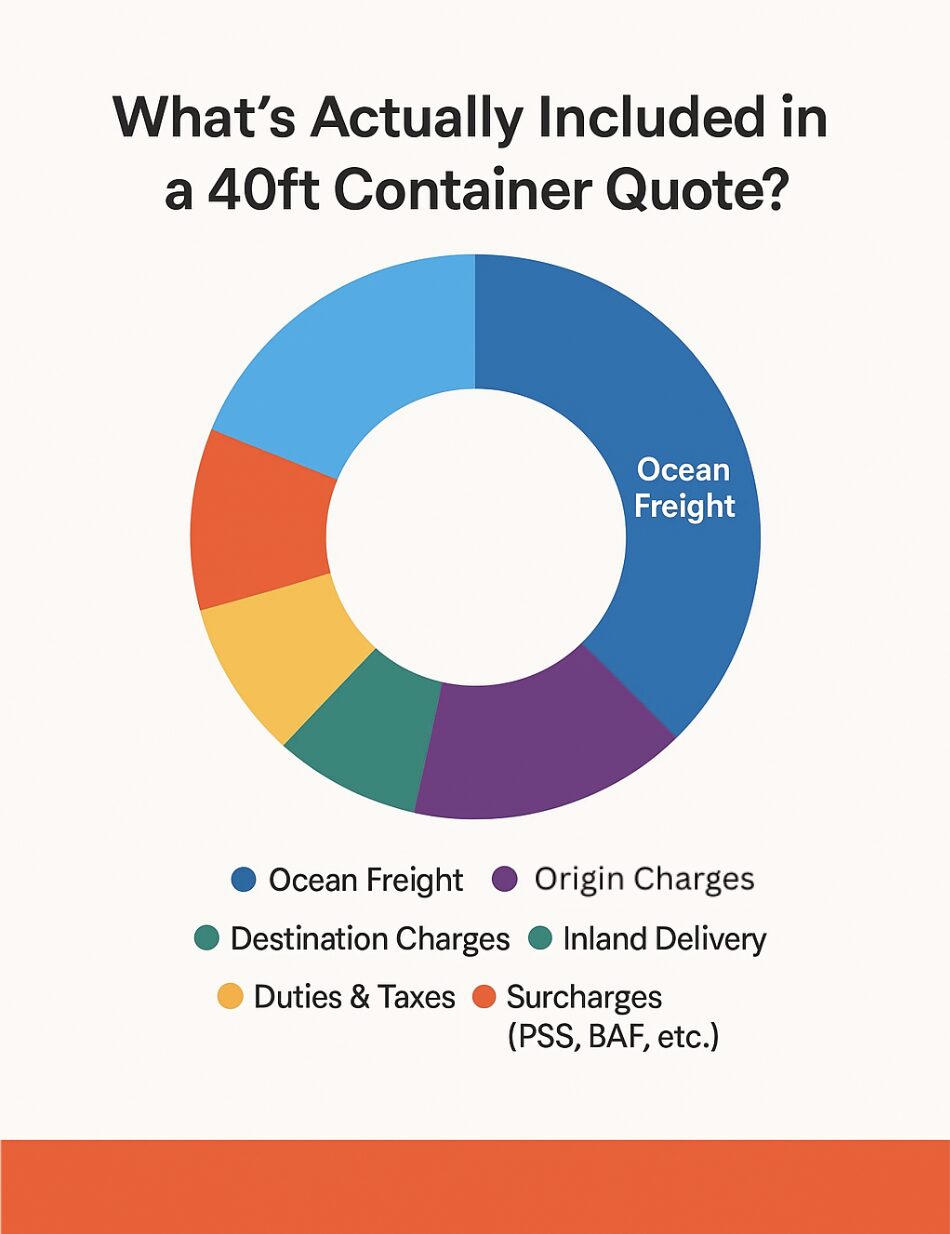Why 40ft Container Cost Is a Big Deal in 2025
Shipping costs have always been a major concern for importers—but in 2025, they’re more critical than ever. Freight rates remain volatile, fuel surcharges are rising again, and global disruptions—from Red Sea detours to port congestion—continue to add unpredictability.
Yet many businesses still underestimate the real cost of shipping. A container might start with a “base rate,” but by the time it arrives at your warehouse, your invoice could double—layered with port fees, handling, customs, inland delivery, and seasonal surcharges.
So, how much does it cost to bring a 40 foot container from China?
The short answer: it depends. This guide walks through what’s typically included in a quote, what drives prices up or down, and real-world examples of how costs play out across routes and shipping models.
What’s Actually Included in the Total Cost
A common mistake among importers is assuming that the ocean freight quote is the full story. In truth, your cost is made up of:
Ocean Freight (Base Rate)
The charge for moving your container from port to port. This is often the most visible line item—but far from the full picture.
Origin Charges
Costs incurred in China before loading:
- Export clearance
- Terminal handling charges (THC)
- Documentation fees
Typically included in FOB quotes, excluded in EXW.
Destination Charges
Fees you pay upon arrival:
- Port handling and unloading
- Delivery order fees
- Potential inspection or cleaning fees
Usually not included unless explicitly listed.
Inland Delivery (If Door-to-Door)
If your cargo needs to reach a warehouse or fulfillment center, add:
- Trucking
- Chassis usage
- Fuel & congestion surcharges
Customs & Duties
Unless you’re on DDP terms, expect to cover:
- U.S. customs duties
- Import taxes (based on product HS code)
- Brokerage or clearance agent fees
These can add 5–20% to your landed cost depending on cargo category.
Surcharges & Seasonality
- Peak Season Surcharge (PSS)
- Bunker Adjustment Factor (BAF)
- General Rate Increases (GRIs)
Costs can increase suddenly during high-demand periods, especially in Q2 and Q4.
Typical 40ft Container Costs by Route in 2025
Based on current container rates, here’s what you might expect to pay for typical 40ft shipments on major port-to-port lanes:
| Route | Base Freight | Total Port-to-Port |
|---|---|---|
| Shanghai → Los Angeles | $1,600–$2,200 | $2,100–$2,800 |
| Ningbo → Long Beach | $1,700–$2,400 | $2,200–$2,900 |
| Shenzhen → New York | $2,500–$3,200 | $3,200–$4,200 |
| Qingdao → Savannah | $2,100–$2,900 | $2,800–$3,900 |
These numbers exclude inland trucking and customs clearance.
For door-to-door shipments, you’ll likely need to add:
- Inland trucking: $700–$1,500
- Fuel, chassis fees, and detention: $150–$400
- Duties and taxes: 5–20% depending on cargo type
Want to explore full-cost scenarios? Check cost of shipping 40ft container from china to usa.

What Drives the Cost Up (or Down)?
Shipping isn’t static. These factors can make your cost rise—or fall:
Peak Season Surcharges
Expect an extra $200–$500 per container in Q2 and Q4.
Port Congestion
Delays at busy ports like LA or NY can lead to:
- Storage fees
- Chassis or container detention
- Rerouting costs if carriers bypass congested ports
Fuel Surcharges
Fuel prices heavily affect rates. When oil surpasses $90/barrel, BAFs can climb significantly.
Spot vs. Contract Rates
Spot rates are flexible but volatile. Contract rates offer stability but may not always be cheaper.
Incoterms
DDP quotes include more services but come with higher premiums. EXW shifts control but increases responsibility.
Container Utilization
Underfilled 40ft containers inflate per-unit costs. Knowing your volume in CBM helps determine if LCL would be more efficient.
Case Studies: Real Shipping Scenarios
FOB Ningbo → Los Angeles
- Base freight: $1,900
- Port fees: $600
- Total: $2,500
High handling costs in LA due to congestion and THC rates.
DDP Shenzhen → New York
- Freight + clearance + delivery: $5,300
Ideal for importers who want no customs or trucking involvement—but it comes at a cost.
Underutilized 40ft vs. LCL
- 40ft FCL half full: $2,200 = $140/CBM
- LCL: $1,650 = $91/CBM
LCL was the smarter choice based on volume.
How to Optimize Your Shipping Budget
Book Early
Secure space 3–4 weeks in advance to avoid last-minute surcharges.
Compare Quotes Properly
Don’t just compare base rates—request full cost breakdowns.
Choose the Right Incoterm
EXW offers more control but adds responsibility. DDP is turnkey but more expensive. FOB is often a balanced choice.
Consolidate Shipments Smartly
If you’re shipping multiple SKUs, consolidate—but only if you can coordinate timelines across suppliers.
Build Relationships
Reliable forwarders offer proactive cost-saving tips and better support when delays or rerouting are needed.
How to Read and Compare a 40ft Container Quote
Many importers focus on the top-line number—but the real value lies in the details. Here’s how to evaluate quotes like a pro:
Check for Complete Line Items
A good quote should include:
- Ocean freight
- Origin and destination charges
- Documentation
- Inland delivery
- Taxes and surcharges (if DDP)
Missing any of these? Ask—don’t assume.
Don’t Chase the Cheapest Rate
A lower rate often means omitted charges that show up later as “unexpected extras.”
Compare by Cost per CBM or Pallet
Especially for shipments under 25 CBM, calculate per-unit cost to evaluate FCL vs. LCL options.
Evaluate the Forwarder
- Do they explain clearly?
- Do they alert you to upcoming rate changes or delays?
- Do they offer customs or paperwork support?
Cost is just one part of the equation—service matters too.

FAQs: What Importers Still Get Wrong in 2025
- Is the quote all-inclusive? Rarely. Always confirm inclusions.
- Are customs and duties included? Only in DDP.
- When is FCL better than LCL? Typically when you have over 18–20 CBM.
- Can I switch ports to avoid congestion? Yes, but only if planned early.
Conclusion: Clarity Before You Book
Shipping a 40ft container is not just a pricing question—it’s a cost structure decision. Understanding each line item is essential for staying profitable and avoiding unpleasant surprises.
Whether you’re shipping bulk cargo to East Coast ports or restocking SKUs via West Coast routes, clarity beats guesswork every time.
That’s why companies like Gorto Freight help importers move with confidence—from factory pickup to final-mile delivery—offering transparent pricing, dependable coordination, and expert guidance.
Before you book, ask:
- Am I looking at the full picture, not just a freight number?
- Do I know what’s excluded?
- Do I trust this partner to flag what’s coming?
If yes, you’re already ahead of the game.

